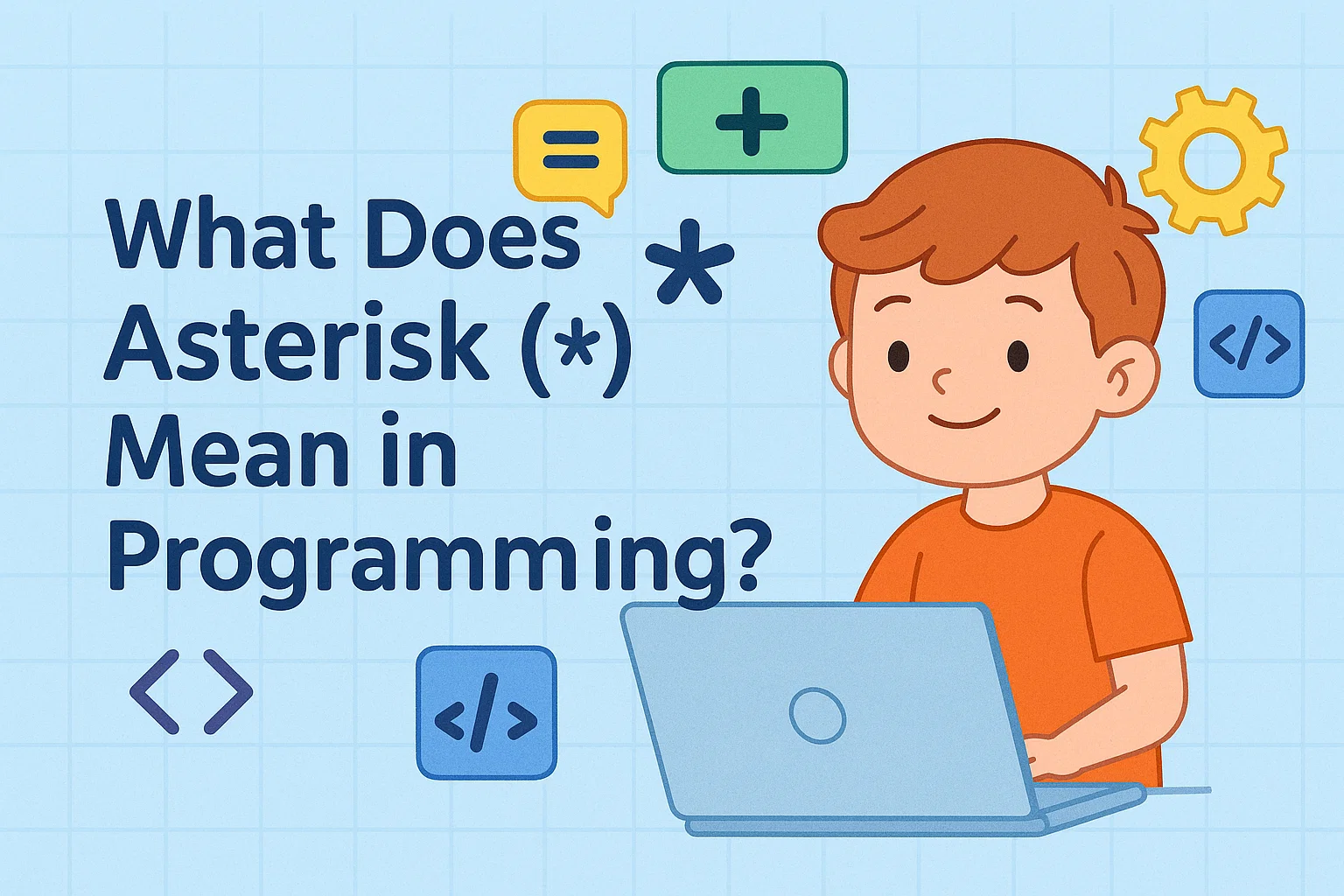If you’ve ever looked at a line of code and seen the little star symbol *, you might have wondered, what does this tiny symbol actually do? Well, that small star is called an asterisk, and it’s one of the most useful and flexible symbols in programming! Whether you’re learning Python, JavaScript, or C++, the asterisk has an important role to play.
Let’s explore what it means, in simple, kid-friendly language. 👇
💡 What Is an Asterisk (*)?
The asterisk (pronounced as-tuh-risk) is a symbol that looks like this: *. In programming, it’s used in many ways — for multiplication, repetition, importing code, and even for special arguments in functions.
Think of the asterisk as a multi-purpose tool — like a Swiss Army knife for coders. 🧠✨
🧮 1. Asterisk as a Multiplication Operator
The simplest use of the asterisk is multiplication.
Example (Python):
result = 5 * 3
print(result)Output:
15
Just like in math, the asterisk tells the computer to multiply two numbers. It’s the most common and beginner-friendly use of *.
🔁 2. Asterisk for Repetition
In some languages like Python, the asterisk can also be used to repeat a string or list.
Example:
print("Hi! " * 3)Output:
Hi! Hi! Hi!
So instead of writing “Hi!” three times, you just use the asterisk — easy and smart! 💬
📦 3. Asterisk for Importing Modules (Python)
When coding in Python, you can use an asterisk to import everything from a module.
Example:
from math import *
print(sqrt(25))Here, * means “import all functions” from the math library — like sqrt(), pi, and others.
🧠 But be careful — using * for imports can make your code confusing if you import too much at once. It’s better for beginners to import only what they need.
🧰 4. Asterisk in Function Arguments
In Python, an asterisk is also used to pass multiple values into a function — these are called args and kwargs.
Example:
def add_numbers(*numbers):
return sum(numbers)
print(add_numbers(2, 4, 6, 8))Output:
20
Here, *numbers lets the function accept any number of inputs — super useful when you don’t know how many values you’ll get.
⚙️ 5. Double Asterisk (**) for Keyword Arguments
A double asterisk ** has its own special use — it helps send key-value pairs (like names and numbers) into a function.
Example:
def student_info(**details):
for key, value in details.items():
print(f"{key}: {value}")
student_info(name="Aarav", grade=5, subject="Math")Output:
name: Aarav
grade: 5
subject: Math
The **details collects all extra information into a single dictionary — that’s Python magic right there! 🪄
🧮 6. Asterisk for Pointers (C and C++)
In languages like C and C++, the asterisk is used to declare and dereference pointers — which means it helps you store and access memory addresses.
Example:
int x = 10;
int *ptr = &x;
cout << *ptr;Here:
int *ptr→ declares a pointer*ptr→ accesses the value stored in the pointer
This is an advanced concept — but in short, the asterisk helps C and C++ talk directly to a computer’s memory. 💾
🔢 7. Asterisk in Regular Expressions (Regex)
In regular expressions (regex), the asterisk means “zero or more times.”
Example:
import re
pattern = "go*gle"
print(re.match(pattern, "google"))Here, o* means the letter “o” can appear zero or more times. So it matches “gogle”, “google”, “gooogle”, and more!
🚀 8. Asterisk in JavaScript (Multiplication and Spread Operator)
In JavaScript, * also means multiplication:
console.log(5 * 4); // Output: 20But JavaScript also has a spread operator written with three dots (...) — a close cousin of the asterisk — to pass all items from one array or object into another.
Example:
const numbers = [1, 2, 3];
const moreNumbers = [...numbers, 4, 5];
console.log(moreNumbers);🎯 In Short
Here’s a quick summary of what the asterisk * can do in programming:
| Usage | Meaning | Example Language |
| Multiplication | Multiply numbers | Python, JavaScript |
| Repetition | Repeat strings or lists | Python |
| Import | Import all from module | Python |
| Function Args | Pass multiple arguments | Python |
| Keyword Args | Pass key-value pairs | Python |
| Pointer | Store memory address | C, C++ |
| Regex | Repeat pattern | Python, JavaScript |
| Spread | Copy or expand elements | JavaScript |
💬 Conclusion
The asterisk (*) might look small, but it’s incredibly powerful. It can multiply numbers, expand lists, import code, and even handle advanced concepts like functions and pointers.
For kids and beginners, learning the asterisk means understanding how computers repeat, multiply, and handle data efficiently, all using just one little star.
So next time you see * in your code, remember: it’s not just a symbol, it’s a superhero of programming!














